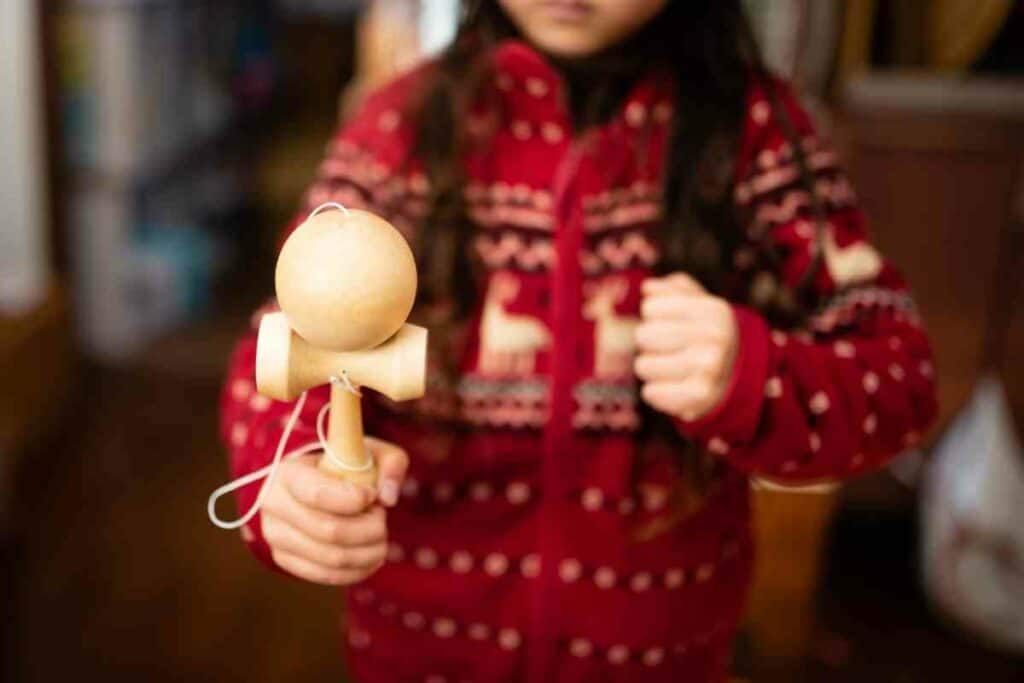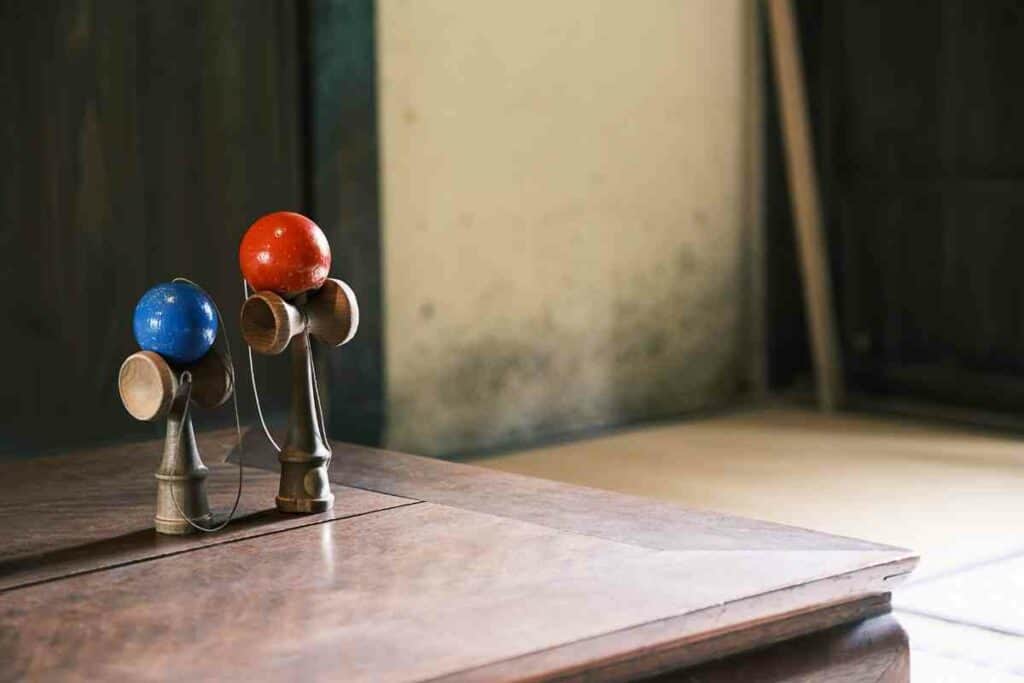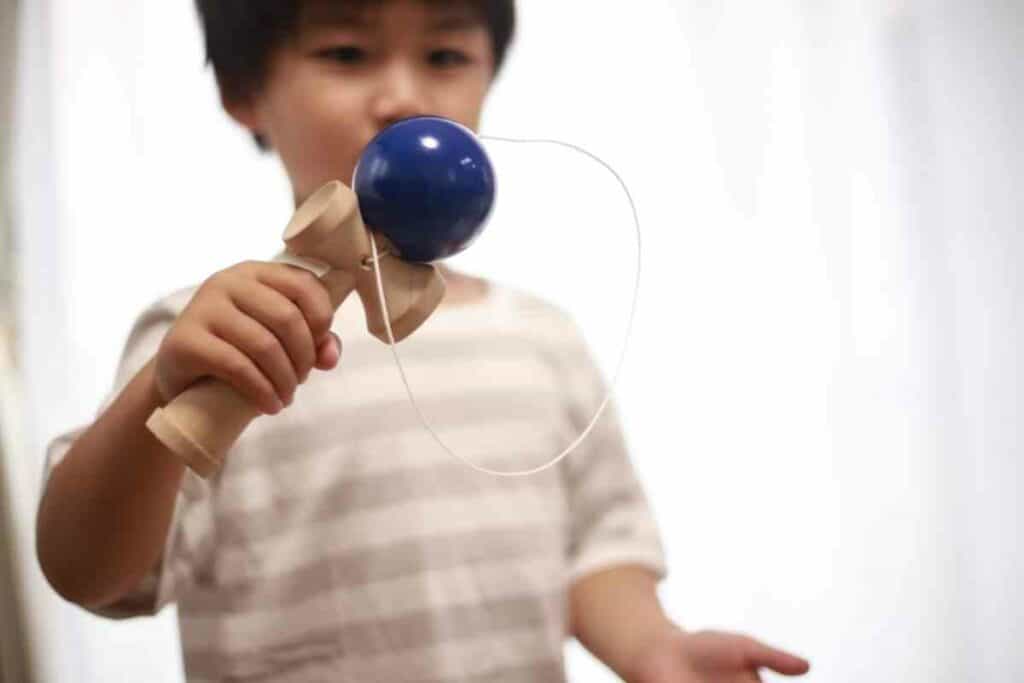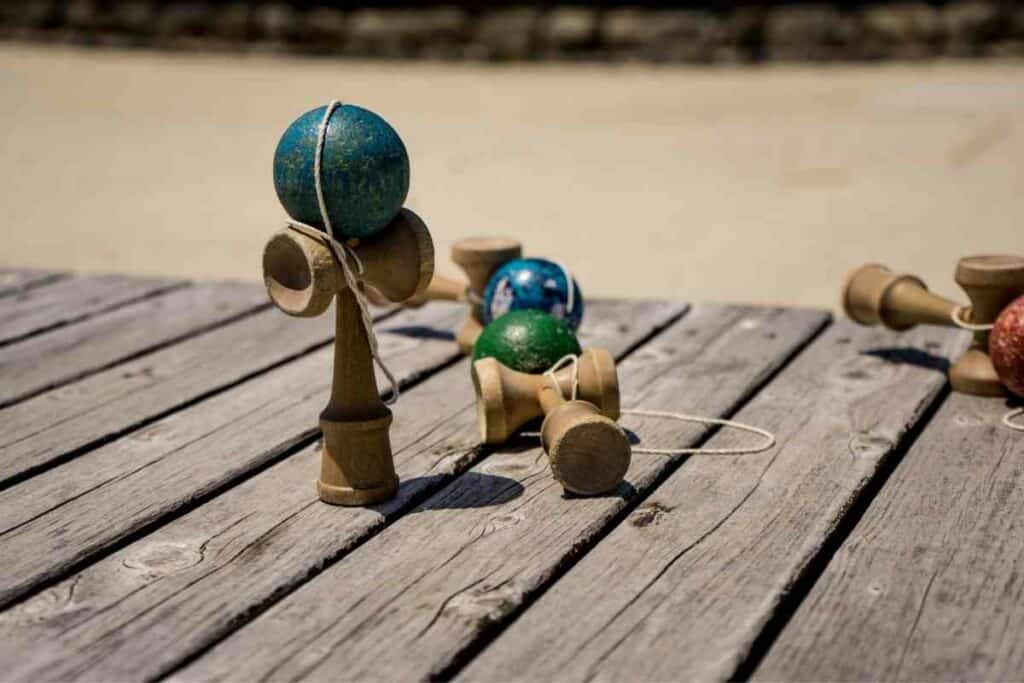The Kendama is a toy that originates from Japan and has a long and interesting history.
The Kendama first appeared in the 17th century as a skill toy made out of wood.

It wasn’t until the early 1900s that the modern-day Kendama was created, made out of bamboo and featuring a ball attached to a string.
Today – The Kendama is still popular in Japan and gaining popularity all over the world. There are many different ways to play with a Kendama, making it an enjoyable pastime for people of all ages.
If you’re interested in learning more about the history and origins of the Kendama, keep reading.
Table of Contents
Kendama Origin and History
The Kendama is a toy that originates from Japan and has a long and interesting history.
The Kendama is made up of three parts:
- the ball (or tama)
- the handle
- and the spike
The ball is attached to the handle by a string, and the player tries to catch the ball in the spike.
History
During the 16th century, popular versions were played by the likes of King Henry the third.

It was thereafter dubbed a Bilboquet. After his death, however, the toy quickly fell out of fashion.
It also found a home in Spanish and Portuguese countries during the 1900s. It was dubbed a Balero or boliche in certain areas.
After traveling from the west to Japan over the Silk Road, the variant of our popular Kendama shape emerged.
Few People Know – Kendama was also utilized by Japanese adults as a traditional drinking game in its early days! When a player made a mistake, he or she was forced to drink.
A stick with a tip on one end, three attached cups, and a ball with a small hole in one end make up a kendama today.
The big cup and tiny cup are the cups on either side of the stick. A 40-centimeter (16-inch) length of the string is used to link the ball to the stick.
The player can attempt to spear the ball with the point at the end of the stick. The medium cup is located at the other end of the stick.

Tossing the ball and attempting to catch it in one of the cups or spearing it with the end of the stick is the fundamental gameplay.
Less-known Fact – Although many people believe that kendama was originated in Japan, this is not the truth. While there are other theories, evidence shows that kendama originated in France in the sixteenth century.
There are various theories that this game was created in Greece or China, but no one knows for certain.
This game was known as bilboquet in France. The words bil and boquet imply “ball” and “small tree,” respectively. This term refers to the fact that the game required the use of a little wooden ball.
The game was played differently back then than it is now:
- A large cup and a little cup were placed on either end of a stick, to which a ball was tied with a thread.
- The player would alternate between the two cups, tossing and catching the ball.
Kendama was played all over the world with several variations.
Greenland is thought to have played kendama about 2,500 years ago. Ajagak’s (Aj’ uh-gahk) were played by youngsters in the Arctic.
A stretch of sinew would attach a spiky bone to a skull or a larger piece of seal bone. They’d hold the spike in one hand, swing the seal bone with the other, and try to catch it on the spike.
Origin
During the Edo period (1603-1868), the Silk Road is thought to have brought kendama to Nagasaki, the only Japanese city open to foreign trade at the time.
While it is thought to have arrived in Japan in the middle of the Edo era, around 1777 or 1778, the exact date is unknown.
Adults were reportedly playing kendama as a drinking game at the time. When a player makes a mistake, he or she is obliged to drink more.
The Ministry of Education included kendama in its report on children’s education in 1876, when Japan entered the Meiji era (1868-1912), and the game quickly gained popularity among young people.

The precursor of today’s kendama was first sold in 1919, during the Taisho era (1912-1926).
Because the ball resembled the sun and the shallow carved cups resembled a crescent moon, it was dubbed Nichigetsu Ball (Sun-and-Moon Ball).
From this time until the start of the Showa era (1926-1989), a variety of various varieties of kendama arose, including a ball attached to a kind of paddle.
Kendama were marketed in candy stores after World War II ended in 1945, among other popular toys like menko, bidama, and beigoma.
Fujiwara Issei, a children’s novelist, founded the Japan Kendama Association in 1975, which standardized kendama for competitive usage and developed standardized rules to allow a larger number of people to play the game in the same way.
Present Day
Kendama became popular as a competitive activity after a set of rules and criteria for the equipment were established.
In addition to the Minister of Education, Culture, Sports, Science, and Technology Award, which is given to the winner of an elementary school kendama competition, there are tournaments for both students and adults held throughout the country, and kendama enthusiasts are working to increase the game’s popularity internationally.

The Japan Kendama Association hopes that one-day kendama will be known all over the world, and its members are working to promote international exchange.
The Kendama World Cup began in the year 2014 and took place in the city of Hatsukaichi, Hiroshima, Japan, and is only hosted during the summer as an annual 2-day event.
The Kendama World Cup is very popular and is taken seriously which is also a highly spectated 2-day annual event.
In 2018 – They recorded to have an audience of over 49 000 spectators, 415 competitors took part in the game and this was watched in 18 countries.
Why Is Kendama so Popular?
There are a few reasons why kendama has become so popular in recent years:
- The rise of social media has meant that more people are aware of the game and can watch others playing. This has helped to create a sense of community around kendama and make it more popular.
- Kendama is a very accessible game. It is easy to learn the basics and doesn’t require any expensive equipment. This means that anyone can pick up a kendama and start playing.
- Kendama is simply a lot of fun! The challenge of trying to catch the ball in the different cups is addictive and satisfying. There is also a great sense of satisfaction that comes from mastering new tricks.
All of these factors have contributed to the popularity of kendama and made it one of the most popular games around.
How Old is Kendamas?
Kendamas date back to the 1700s, when they were created in Japan.

Though their exact origins are unknown, it is believed that they were inspired by a traditional French game called bilboquet.
The name “kendama” comes from the Japanese words “ken”, meaning “sword”, and “tama”, meaning “ball”.
The toy became popular in Japan in the early 1900s, and began spreading to other countries in the mid-20th century.
Today, kendamas are enjoyed by people of all ages all over the world.
Conclusion
The Kendama is believed to have originated in Japan and its exact origins are unknown.
It is thought that the toy was first made from natural material such as wood, but it is now also made from plastic or metal.
The Kendama has been popular in Japan for centuries and there are many different theories about how it became so popular.
Some believe that the Kendama was first introduced to Japan by the Portuguese, while others believe it was brought over by Chinese immigrants.
Regardless of its origins, the Kendama has been a popular toy in Japan for many years.
Read Next
- Sumo Wrestler Suit for Adults by TOLOCO: Best Sumo Suit?
- Eki Stamp Book (Gotta Collect Them All!)
- Explore the Fascinating World of Japanese Rubik’s Cubes
- Tenkara Fishing and 3 Best Japanese Fishing Rods for the Job
- Are Drones Allowed In Japan? (About Japan’s Drone Laws)
- 6 Best Comic Book Stores In Tokyo









